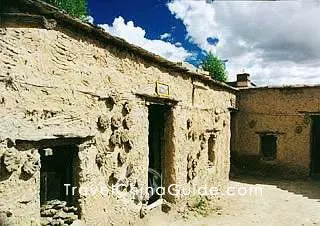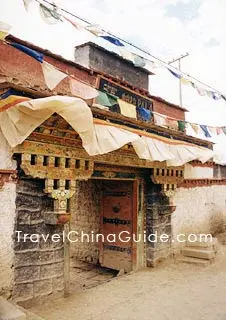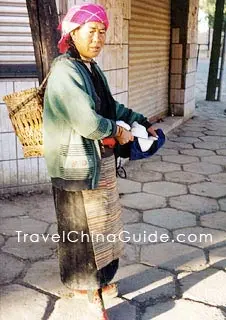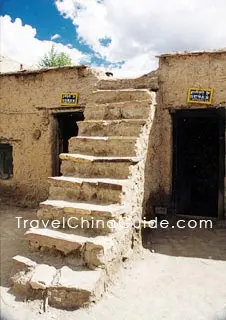Pala Manor
 |
Originally Pala, the former owner of the Manor, was a Bhutanese chief but due to civil strife in Bhutan, he moved to Tibet with his family where in due course he became a local official. At the time of the Tibet Democratic Reform in 1959 he left Tibet along with the Dalai Lama to live in exile.
In the days before the Democratic Reform, the Pala Manor had included twenty-two smallholdings, six lots of grassland and farmland covering some 8,600 Mu (1414.45 acres). More than 14,250 cattle were grazed here and 2,440 serfs worked on the estate. Their tasks included general farm labour and animal husbandry as well as wine production. In addition many were engaged in knitting, sewing and the catering chores and other tasks necessary for the running of the estate. The peasantry had virtually no freedom, were treated harshly and suffered a very inadequate standard of living. Yet through their labour they helped provide their master with a grand lifestyle while they lived in dark and overcrowded conditions with a lack of amenities that could hardly be imagined in a modern society.
The Pala Manor we see today still has fifty-seven houses on an estate with an area of approximately 5,000 square metres (1.24 acres). The main building is a three-storey structure that includes a scripture hall, reception hall, and bedrooms. In addition to the lobby used for playing the Chinese game of Majiang there are many other reception halls. The maze of rooms is richly decorated with exquisitely carved beams and painted rafters.
One will be genuinely amazed by what can be seen on display in Pala Manor, for many of the original contents of the reception rooms and bedrooms remain on show. Among the items there are an ox horn that would be filled with Qingke (a highland barley wine), fine porcelain bowls for containing ghee, an ivory Majiang set as well as precious fur clothes, glass cups, tins of biscuits and whiskey imported from Britain. The sun-room walls are hung with tiger and deer skins and further evidence of the wealth of the former owner are such things as a gold saddle and two gramophones that were manufactured in Great Britain. The other recreation rooms include a modern gymnasium with facilities for table tennis, badminton and other physical training equipment including ice-skates.
There are other foreign imports ranging from mundane things such as soy sauce and vinegar to more elaborate items such as ivory fans, rock crystal glasses and wristwatches as well as a range of cosmetics that would have been used by Pala's womenfolk. There are a great many things on show that would have been luxuries some half century ago. The exhibits in Pala Manor include many very valuable items of jewellery fashioned from sapphires, turquoise, rubies, agates, diamonds and various other precious stones. Such was the wealth that was taken for granted by the Pala family while elsewhere the visitor can see how the unfortunate peasants were treated. Manacles, instruments of torture including blackjacks and punishment cells are on view.
Nowadays, things are very different, as modern buildings have been erected around Pala Manor. The former serfs now reside in them living a happy life with their offspring. Their old shabby houses remain as relics of a cultural past. The people now breed their own cattle, horses and sheep, something they could never have dreamed of just fifty years ago.
 |  |  |
How to get to Pala Manor from Lhasa
2. Take a bus from Xijiao Bus Station to Shigatse and then take a bus to Gyangtse; after arrival, take a taxi to Pala Manor.
| Entrance Fee | CNY 25 |
|---|---|
| Opening Hours | 9:00 - 18:00 |
- Last updated on Aug. 15, 2025 by Demi Li -